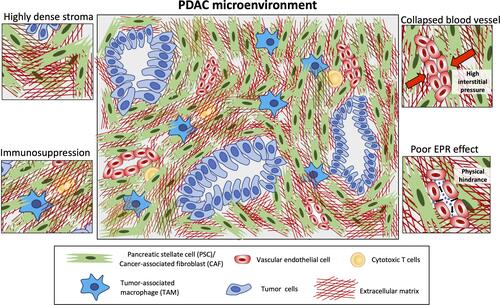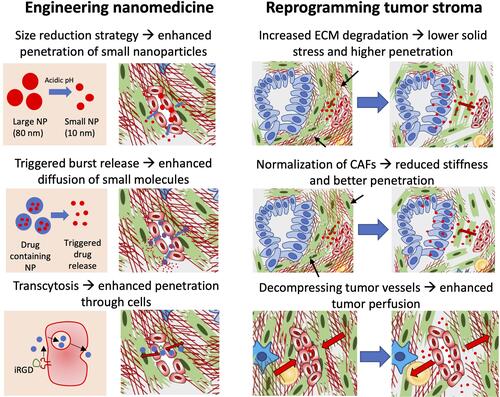Figures & data
Figure 1 Key features of the PDAC microenvironment. This diagram highlights highly dense stroma and its impact on immune infiltration (entrapped immune cells) leading to immunosuppression, collapsed blood vessels due to high interstitial pressure, and poor enhanced permeability and retention (EPR) effect hindering nanoparticles to penetrate into the tumor.

Table 1 Pancreatic Cancer Clinical Trials of Nanomedicine Strategies for Drug Delivery (Referring from https://clinicaltrials.gov/)
Table 2 Summarizing the PDAC Features Effecting Tumor Perfusion and Penetration and Potential Solutions
Figure 2 Diagrammatic representation of different strategies to enhance tumor penetration of nanomedicine. To enhance the penetration, either nanomedicine can be engineered or the tumor stroma can be re-programmed. Nanomedicines can be tuned by size reduction strategy in which the size of nanoparticles (NP) is reduced upon reaching the tumor site, which allows deeper penetration into the tumor. In another strategy, one may induce triggered release of drug allowing rapid diffusion of small molecules into the tumor. In the third strategy, use of a transcytosis mechanism is interesting to induce penetration of nanoparticles through endothelial cells, for example using iRGD peptide. Other approaches are based on reprogramming of tumor stroma. In this approach, one may induce degradation of ECM using enzymes such as MMPs to reduce the physical barrier and solid stress or by reducing stiffness by normalization of CAFs. These approaches help in enhancing penetration by modulating physical microenvironment. Although reduction of ECM will lead to decompression of blood vasculature, relaxation of blood vessels using anti-hypertensive agents can induce tumor blood perfusion.

